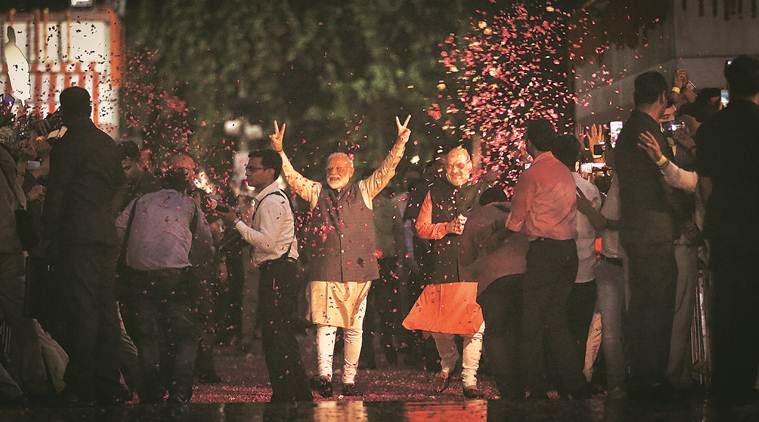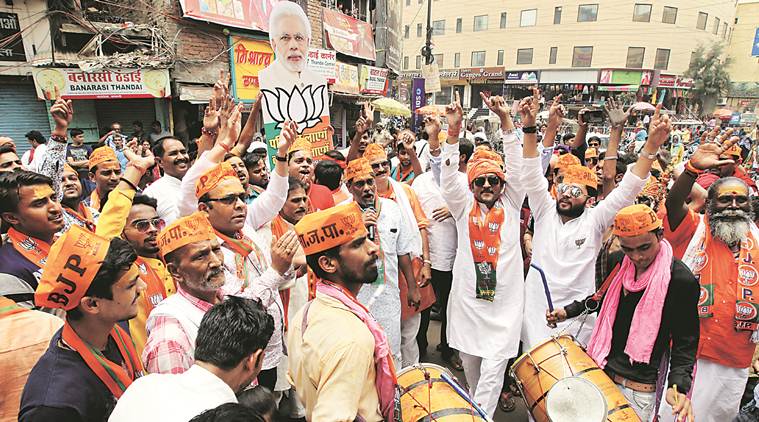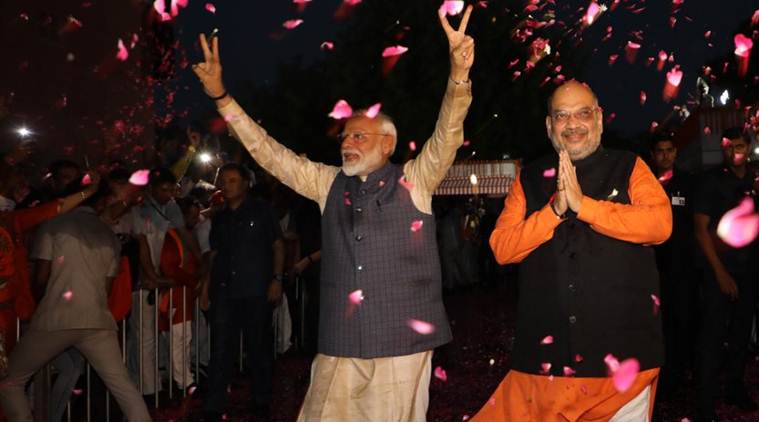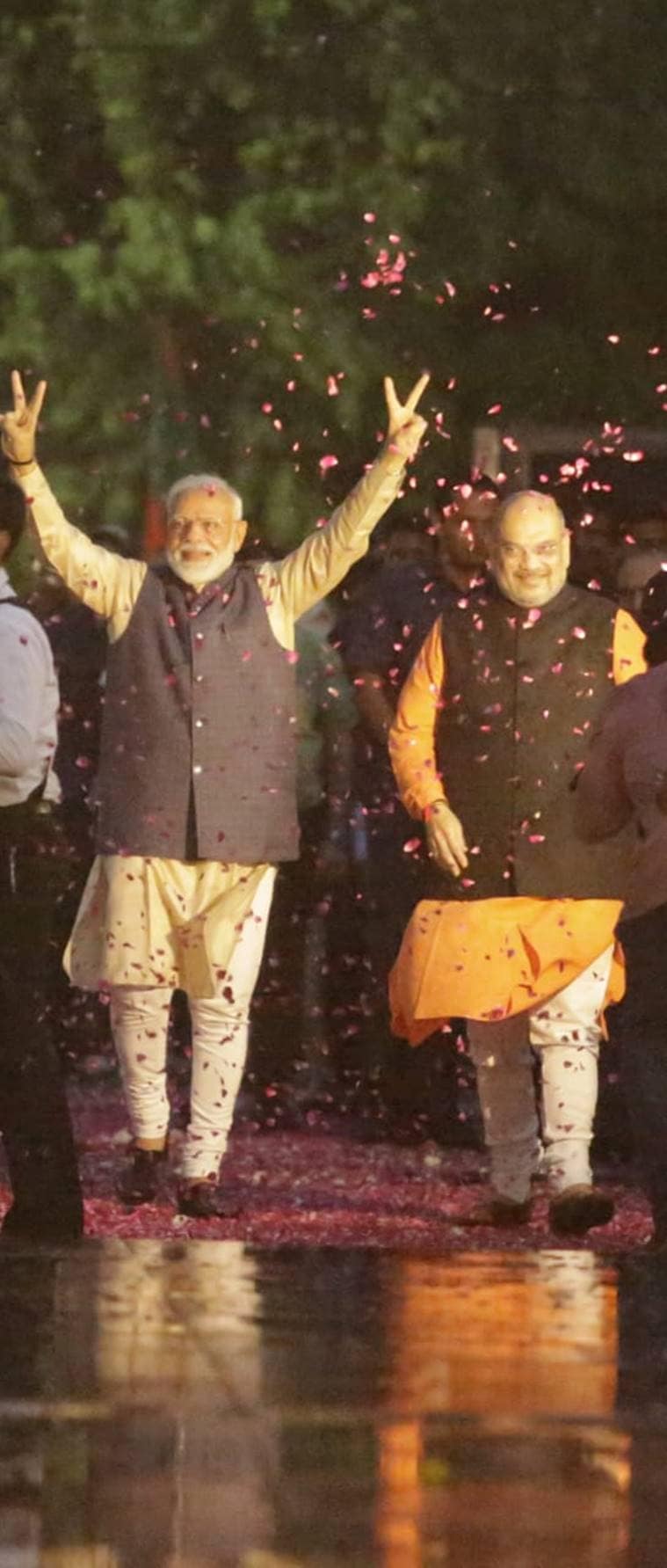Lok Sabha elections 2019 results: As countdown to 2019 began, he was already being seen as strong and decisive leader, a disruptor seeking change.
In five years, Brand Modi has transcended religious, caste and class divisions. That, in a nutshell, is Decision 2019.
From the time he was first named prime ministerial candidate in September 2013, Modi has never looked back. He has built on his strengths, charting the course the country will take, and also his party. In election after election, in state after state.
So when the countdown to 2019 began, he was already being seen as a strong and decisive leader, a disruptor seeking change, the poster boy of millions being tapped by the BJP.
READ | Will build ‘strong & inclusive India’, PM Modi tweets after resounding victory
Home and abroad
Since the time he led the BJP to power in 2014, Modi has shown an eye for the visual. His oath-taking ceremony was held in the forecourt of Rashtrapati Bhavan, the glow of the setting sun as a backdrop, and eight foreign heads of government in attendance. His first Republic Day appearance had US President Barack Obama as chief guest. His public meeting at the Madison Square Garden was a rockstar-like event.
READ | Decoding 2019 Lok Sabha elections verdict
At major events and meetings, he has bonded with global leaders. Overseen by a team of the BJP, led initially by general secretary Ram Madhav and later by Vijay Chauthaiwala, these foreign visits have also helped the party build a fervent base among the Indian diaspora.
If technology has helped him connect with party workers down to the booth level, his Mann Ki Baat addresses have helped him reach the common man. Today, Brand Modi is big. Yet five years in power have not changed his image of an “outsider” working hard to “set things right”.
EXPRESS DATA | Election results dashboard
He has been under constant attack from the Opposition but the mandate indicates that Modi’s message and campaign — of Good Governance, Nation First, raising India’s stature, fighting corruption, teaching Pakistan a lesson — have worked on the ground.
READ | BJP’s heartland surge flattens identity politics in UP, Bihar
The initiatives
The promise of Achhe Din was an integral part of Modi’s 2014 campaign. Promising to change the nation, he announced the launch of the Swachh Bharat Abhiyan on Mahatma Gandhi’s birth anniversary. Critics called it a modification of the Nirmal Bharat Abhiyan of the UPA, but this did not cut any ice. In fact, this initiative helped the party appropriate the Mahatma.
His government followed this up with the National Mission for Clean Ganga, reiterating its commitment to the river millions consider holy; Mudra Yojana for affordable credit to micro and small enterprises; Beti Bachao Beti Padhao for the girl child; and legislative initiatives like banning instant triple talaq — all directed towards its goal of Sabka Saath Sabka Vikas.
READ | ‘Janta maalik hai’: Rahul Gandhi concedes defeat, says will respect people’s mandate
Critics countered this by questioning the BJP’s silence on issues such as lynchings, cow vigilantism and attacks on Dalits. Each time, Modi stepped in to express his “displeasure”. And succeeded.
The risk-taker
Be it the choice of candidates, chief ministers, economic initiatives or national security decisions, Modi has gone against the grind. The selection of CMs for Maharashtra, Haryana and Jharkhand ignored caste conventions. Devendra Fadnavis, a Brahmin, was picked for Maharashtra where Marathas have dominated the political scene, non-tribal Raghubar Das was chosen to lead the team in Jharkhand, and Manohar Lal Khattar, who is not a Jat, was asked to lead Haryana.
Known to take decisions on his own — even while he was CM in Gujarat — Modi gave further proof of this in charting foreign policy, especially in dealing with Pakistan. The surgical strike of 2016 and the Balakot air strike this year endeared him to the masses.
Explained: What the results mean for Rahul Gandhi and Congress
On the economic front, one of his most disruptive moves was demonetisation. Many called it a huge political risk, given that elections in Uttar Pradesh were approaching. But Modi and the BJP survived the fallout of the noteban. He told the people that demonetisation was good for the country and a blow to corruption.
READ | Delhi saffronwash: Why even an AAP-Congress alliance couldn’t have stopped BJP
The rollout of the GST was seen as another move that would antagonise traders who constitute a core support base of the BJP. “Be it taxes on fuel, GST or demonetisation, many advised Modi to step back; he was told of big political calamity or threat to his position,” BJP leader and author of ‘Narendra Modi — Creative Disruptor: The Maker of New India’ R Balashankar wrote in his book.
Modi told the country he was able to do things his predecessors could not since he was “an ordinary” man with “raw wisdom”. And that this had helped him lift India out of its “debt crisis” and “economic mess” created by the Congress-led UPA. The sharp jump of India’s rank in the Ease of Doing Business Survey helped burnish that image. Good rankings by international rating agencies and appreciation from global institutions helped build a positive narrative for Modi. Critics continue to raise questions but this election has seen voter after voter giving the PM the benefit of doubt: “How much can one man do?”
READ | As BJP makes big gains in Bengal, is it end of the road for Left, Congress?
Outreach to Dalits, poor
Seen as a party of the upper castes, the Modi-led BJP made a concerted push to bring the 16.6 per cent Scheduled Caste population under its umbrella, and had 40 Dalit MPs. One of its masterstrokes was picking Ram Nath Kovind, a Dalit leader from Uttar Pradesh, as the President. The BJP has also assiduously celebrated Dalit icon B R Ambedkar — from a series of programmes on his 125th birth anniversary, social harmony feasts on Ambedkar Jayanti to setting up of Ambedkar international centres, holding of special Parliament sessions and celebration of November 26 as Constitution Day.
The other outreach was to the poor. Projecting the Congress’s programmes to eliminate poverty as total failures, the Modi government overhauled many schemes. The BJP succeeded in convincing people that insurance schemes announced by the Modi government had secured lives, the Jan Dhan Yojana had financially empowered them; Ujjwala scheme for LPG connections to the poor had provided a clean cooking medium; the Pradhan Mantri Awas Yojana had made affordable housing possible; Ayushman Bharat had ensured quality healthcare; and PM-KISAN would take care of small and marginal farmers. His emphasis on open-defecation-free villages and toilets made him a Prime Minister concerned with the health of the poor. The message consistently hammered home was that the total beneficiaries of these schemes numbered 22 crore.
Long ago, Modi had said: “I have the ability to pick stones thrown at me to build a staircase to climb up.” Decision 2019 has shown just that.
Who is the election result winner in your Lok Sabha constituency? Click here to find out. Get real-time updates, news and analysis on the 2019 Lok Sabha election results only at indianexpress.com/elections | For a deep dive on the elections check out data.indianexpress.com
Source: Read Full Article






